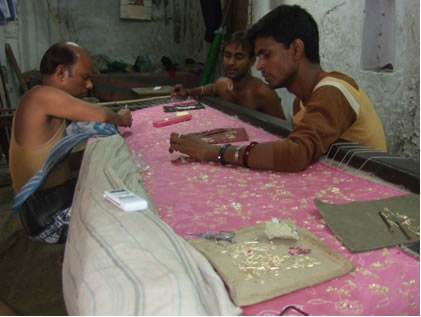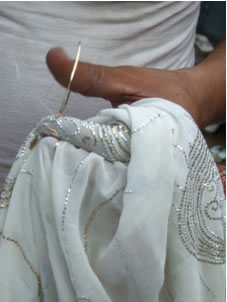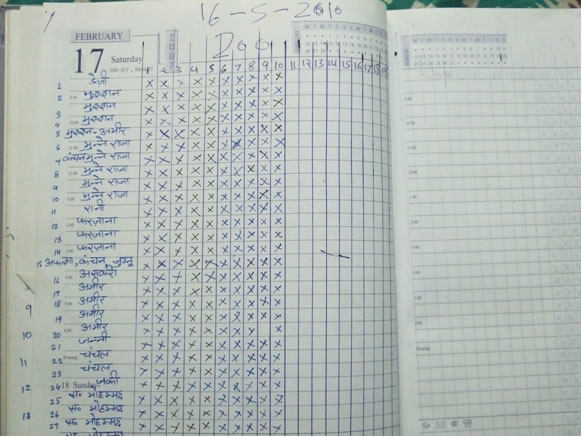Project Year
2009
Region(s)
South Asia
Country(ies)
India
Project Description
This project will attempt to study how the poorest of the poor are able to survive
and manage their monetary resources with minimal risk. It consists of ethnographic
research among conducted among the Shia Zardozi (embroidery) workers in old city area
of Lucknow, India, who invest in Beesi networks. Beesi networks are informal groups
of 20 women who pool their resources to manage risk.
Researcher(s)
Syed Aiman Raza
About the Researcher(s)
 Syed Aiman Raza has his PhD in Anthropology from the University of Delhi in Delhi, India. He received
a doctoral fellowship from the Indian Council of Social Science and Research (ICSSR)
and lectures at the Shia Degree College.
Syed Aiman Raza has his PhD in Anthropology from the University of Delhi in Delhi, India. He received
a doctoral fellowship from the Indian Council of Social Science and Research (ICSSR)
and lectures at the Shia Degree College.
Synopsis of Research Results
This study contributes to research on informal financial networks known as Beesi among poor skilled Zardozi (embroidery) workers in Lucknow. Beesi are a kind of rotating
savings and credit association. Each member contributes a weekly or monthly sum and
the pot is given to a member selected randomly by lottery. In these Beesi networks,
members can transfer their right to the funds to another person in the network. The
study also documents other money management practices, and provides quantitative data
on food, medical and educational expenses for a population experiencing poverty, large
income fluctuations and ethno-religious segregation.
Research was conducted among 60 households belonging to the Athna Ashari Shia sect
who are involved in embroidery work from two distinct Shia-dominated districts. Purposive
sampling was done to target the poorest and most vulnerable members of the Zardozi
occupational group who earn on average less than US$2/day throughout the year. A census
was conducted as well as participant-observation and in-depth, narrative interviews.
Women and men were interviewed individually; focus groups were also conducted.

Zardozi is not merely needlecraft but also a vestige of a bygone and more opulent
era. Embroidery using gold and silver threads, precious stones and patterns on velvet,
chiffon, crepe and silk evoke nostalgia for the past age of Shia Nawabs, the honorific used by rulers of Avadh after the disintegration of the Mughal empire.
Not surprisingly, despite their poverty every Zardoz today proudly claims to be a
part of this illustrious heritage. The craftsmen trace the genesis of this art to
the prophet Yosuf (Joseph) and his famous robe. During the last three decades there
has been a resurgence of the craft related to the desire for “ethnic couture” for
bridal wear and for the fashion industry in India and beyond, with a boom in exports
to Europe and the Middle East. The migration of Zardoz to Saudi Arabia and Dubai has
become more common, as well. Cultural notions of dignity distance this Shia community
from other skilled occupations like butchery or cooking, allowing them to escape the
stigma attached to lower caste groups.
The longer ethnography resulting from this research documents the organization of
work among the Zardoz, many of whom are self-employed but connected to an office or
local boutique. Offices receive orders – some very large – and distribute them to
branches, local groups of Zardozi, and seeks the lowest possible rate for the labor.
Negotiation over nafri or daily wages is intense. Due to the complexity of the design of a particular order,
the actual hours worked often exceed the amount previously negotiated with the office,
however, leading to requests for higher nafri, which cause offices to reject completed
pieces of cloth. The branch still has to pay the nafri to the workers, however. Zardoz
cannot get work directly on their own, and so are bound to the offices and branches.
As one 50-year old self-employed Zardoz states, “We cannot bring work directly from
the metro cities like Delhi and Mumbai for a simple reason: it requires a lot of capital
investment… The Offices bag orders from Delhi, Punjab, Mumbai, and local shops. …
Offices get bulk orders, 500-1000 pieces in a season. They get their payment only
after all the pieces are cleared and checked by the shops or business houses. … [So]
only Offices can afford to invest such huge sum of money with risk.” Zardoz and Offices
try to guard their designs, and Zardoz also alter designs subtly based on the wages
offered.

The research tracked the seasonal variations in income received as well as expenses.
It also documented the everyday struggle for electricity, since lighting is needed
for the intricate work. Informal (and often illegal) means of obtaining current abound,
with people paying rent to friends with regular electrical service in exchange for
a hook connected to their line. Electricity cuts into the nafri of a Zardoz: often
a worker will be paid a certain wage for 8 hours of work ($1.67-$1.88) but will be
offered double if he works an additional 4 hours. However, there are only so many
hours of adequate light in the day.
Zardoz tell stories of better lives in Saudi Arabia, where working conditions are
better and according to one interviewee there are “stringent rules and regulations”
which “helps you reap benefits from your tireless attitude and hard work.”
Festivals and majlis or “sittings” at home involving relatives and friends retelling religious stories
are important but expensive. The research documents the seasonal and ongoing expenses
associated with these social and ritual obligations. Yet these events also promote
informal lending of small amounts of money, milk, sugar, tea, kerosene and wheat.
 Beesi
Beesi – informal savings associations – turn out to be key to easing out the money crunches
that occur because of religious obligations and big ticket purchases like school fees,
clothing, medical expenses and marriage. The Zardoz find Beesi uncomplicated, localized
and efficient, and have no other saving mechanism. They view the risk levels as low
mainly because of trust established through existing social ties. Beesi organizers
pay in case a member defaults, and so the organizers remain on their toes when receiving
weekly or monthly installments from members. The research chronicles the life of two
Beesi networks, one with 23 members and one with 60. One takes in installments monthly,
and the other weekly. Payouts are by lottery. The payout for the larger of the two
is $479, and the smaller $125. The drawing of the lottery takes place in front of
all the members. However, based on mutual understanding, the Beesi payout is often
transferred from the winner of the lottery to the person in most need. A large proportion
of the income gets managed this way. The women who organized both of Beesis in the
study reported that members will skip meals in order to pay their Beesi installments.
Although people’s everyday needs predominate in their use of money, their religious
and ritual obligations are expensive. One interviewee spoke at length about these
obligations and their cost. But this is a cost worth it for maintaining one’s position
before one’s neighbors and God, a position that remains important to these poor but
skilled artisans whose craft connects them to a more glorious past.
 Syed Aiman Raza has his PhD in Anthropology from the University of Delhi in Delhi, India. He received
a doctoral fellowship from the Indian Council of Social Science and Research (ICSSR)
and lectures at the Shia Degree College.
Syed Aiman Raza has his PhD in Anthropology from the University of Delhi in Delhi, India. He received
a doctoral fellowship from the Indian Council of Social Science and Research (ICSSR)
and lectures at the Shia Degree College.
 The research tracked the seasonal variations in income received as well as expenses.
It also documented the everyday struggle for electricity, since lighting is needed
for the intricate work. Informal (and often illegal) means of obtaining current abound,
with people paying rent to friends with regular electrical service in exchange for
a hook connected to their line. Electricity cuts into the nafri of a Zardoz: often
a worker will be paid a certain wage for 8 hours of work ($1.67-$1.88) but will be
offered double if he works an additional 4 hours. However, there are only so many
hours of adequate light in the day.
The research tracked the seasonal variations in income received as well as expenses.
It also documented the everyday struggle for electricity, since lighting is needed
for the intricate work. Informal (and often illegal) means of obtaining current abound,
with people paying rent to friends with regular electrical service in exchange for
a hook connected to their line. Electricity cuts into the nafri of a Zardoz: often
a worker will be paid a certain wage for 8 hours of work ($1.67-$1.88) but will be
offered double if he works an additional 4 hours. However, there are only so many
hours of adequate light in the day. Beesi – informal savings associations – turn out to be key to easing out the money crunches
that occur because of religious obligations and big ticket purchases like school fees,
clothing, medical expenses and marriage. The Zardoz find Beesi uncomplicated, localized
and efficient, and have no other saving mechanism. They view the risk levels as low
mainly because of trust established through existing social ties. Beesi organizers
pay in case a member defaults, and so the organizers remain on their toes when receiving
weekly or monthly installments from members. The research chronicles the life of two
Beesi networks, one with 23 members and one with 60. One takes in installments monthly,
and the other weekly. Payouts are by lottery. The payout for the larger of the two
is $479, and the smaller $125. The drawing of the lottery takes place in front of
all the members. However, based on mutual understanding, the Beesi payout is often
transferred from the winner of the lottery to the person in most need. A large proportion
of the income gets managed this way. The women who organized both of Beesis in the
study reported that members will skip meals in order to pay their Beesi installments.
Beesi – informal savings associations – turn out to be key to easing out the money crunches
that occur because of religious obligations and big ticket purchases like school fees,
clothing, medical expenses and marriage. The Zardoz find Beesi uncomplicated, localized
and efficient, and have no other saving mechanism. They view the risk levels as low
mainly because of trust established through existing social ties. Beesi organizers
pay in case a member defaults, and so the organizers remain on their toes when receiving
weekly or monthly installments from members. The research chronicles the life of two
Beesi networks, one with 23 members and one with 60. One takes in installments monthly,
and the other weekly. Payouts are by lottery. The payout for the larger of the two
is $479, and the smaller $125. The drawing of the lottery takes place in front of
all the members. However, based on mutual understanding, the Beesi payout is often
transferred from the winner of the lottery to the person in most need. A large proportion
of the income gets managed this way. The women who organized both of Beesis in the
study reported that members will skip meals in order to pay their Beesi installments.


